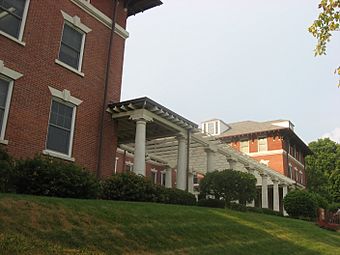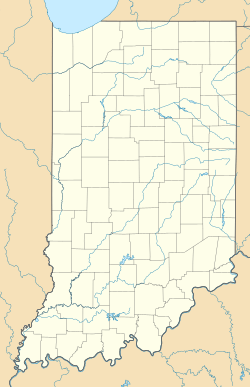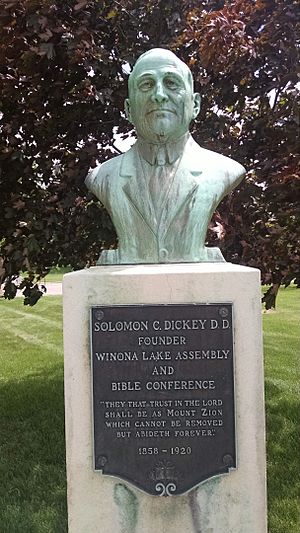Winona Lake Historic District facts for kids
The Winona Lake Historic District is a special area located on the eastern shore of Winona Lake in Kosciusko County, Indiana. It's known for its interesting past as a popular place for summer fun, learning, and religious gatherings.
This district has been officially recognized for its history. It was added to the National Register of Historic Places in 1993. This means it's an important place to protect and remember.
Contents
How Winona Lake Began: The Chautauqua Era
In 1888, a man named J. F. Beyer bought the land around what was then called Eagle Lake. He and his brothers ran a dairy business nearby. They liked the area because it had many natural springs. These springs could keep things cold, which was great for their dairy business.
But the Beyer brothers had bigger plans! They created Spring Fountain Park as a summer resort. It was also a "Chautauqua" site. A Chautauqua was a popular event where people could learn, be entertained, and enjoy nature.
The park had fun things like a race track and a small roller coaster. They built a hotel and an auditorium for talks and shows. The very first program featured John Heyl Vincent. He helped start the original Chautauqua in New York.
A New Focus: Religion and Learning
In 1894, the land was bought by the Presbyterian Church of Indiana. This deal was made by Solomon C. Dickey. He was an important leader for the church in Indiana. Dickey soon became a very respected person in Winona Lake.
Dickey changed the lake's name to Winona Lake. In 1895, he started the Winona Assembly and Summer School. While Chautauqua events often had some religious parts, Dickey wanted to make religion a bigger focus. So, Bible conferences started right away in 1896.
Many famous people were involved with the "Assembly." These included H. J. Heinz (who started the food company) and John Studebaker (who made cars). Well-known speakers like J. Wilbur Chapman and William Biederwolf led the Bible conferences.
Lots of famous performers and speakers visited Winona Lake. They were part of the Chautauqua "circuit," traveling to different places. Some of these famous visitors included former President Benjamin Harrison and politician William Jennings Bryan. Others were explorer Admiral Richard Byrd, inventor Glenn Curtiss, and author Helen Keller. Even comedian Will Rogers, poet James Whitcomb Riley, and social reformer Jane Addams came to visit.
In 1911, the famous preacher Billy Sunday moved his family to Winona Lake. He built a special house called an Arts and Crafts bungalow. This house is now the Billy Sunday Home Museum. Billy Sunday's song leader, Homer Rodeheaver, also moved to Winona Lake. Many small summer schools were also started there.
Winona Lake: A Center for Bible Conferences
Around 1910, Winona Lake was very popular. About 250,000 people visited each year! But by 1915, fewer people were coming. The full Chautauqua programs started to slow down.
However, the Bible and prophecy conferences stayed strong. These meetings became the main focus of Winona Lake. They also showed a shift towards a type of Christian belief called fundamentalism. Still, Winona Lake remained a key spot for many different religious leaders and activities.
For example, the group Youth for Christ was started in Winona Lake in 1944. The famous preacher Billy Graham spoke in the Billy Sunday Tabernacle in 1949. Graham and other Youth for Christ leaders even had an all-night prayer meeting in the Westminster Hotel. Many locals remember this event as something that helped launch Billy Graham's amazing career.
By the 1960s, the "Assembly" had money problems. Even the Bible Conferences were getting smaller. In 1968, Grace College and Theological Seminary bought the grounds. The school also took on the Assembly's large debts.
Winona Lake's New Beginning
In the 1980s, many of the old buildings were falling apart. The historic district looked quite run down. But things changed in the year 2000! Local business leaders invested a lot of money and effort. They created The Village at Winona. They also started other fun projects for the town.
This big effort included fixing up the old historic buildings. They built small shops along the canal. Cultural events were organized, and the Reneker Museum of Winona History was created (now The Winona History Center). They also encouraged outdoor activities and recreation. While these big changes happened around 1998-2000, members of the Winona Historical Society had been working to raise awareness and make small improvements since at least 1990.
Historic Buildings You Can Still See
Many historic buildings remain in the Winona Lake Historic District. They tell the story of this special place.
- The Winona Hotel (first called Eagle Lake Hotel)
- Westminster Hall (also known as the Presbyterian Building or Westminster Hotel)
- Mount Memorial (originally the Free Methodist Publishing House)
- Billy Sunday Home
- The Franconia (a home)
- The Administration Building
- The Beyer Home
- Killarney Castle (Solomon Dickey's home)
- The Railroad Power Station
- Church of the Good Shepherd
- Winona Lake Free Methodist Church
- Swiss Terrace Homes (like The Geneva and Interlaken)
- ZB Frathouse
- The Lookout
Images for kids






